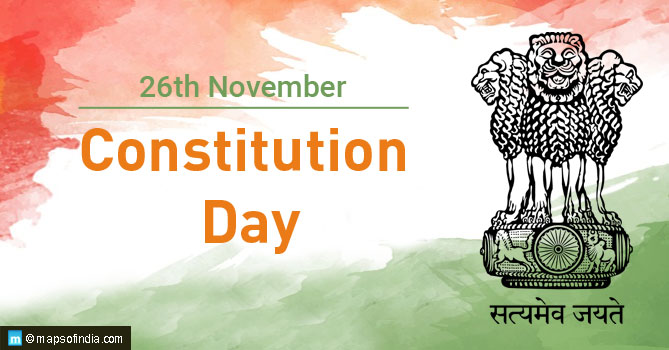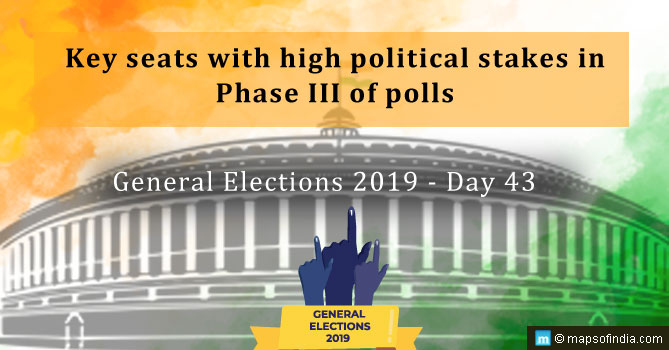
At the stroke of midnight, India became independent in 1947. And three years later, a new constitution was promulgated by the Constituent Assembly and India declared itself as a “sovereign democratic republic”. The Constitution Day of India 2019 marks the 70th Anniversary of the adoption of the Constitution. This day is very important because it was on this day in 1949 when India as a country heralded a new dawn. The Constitution came into effect on January 26, 1950.
J&K Celebrates this day for the first time
Although this day is celebrated across India in schools, colleges and offices by reading the Preamble of the Constitution, by enacting plays and organizing quiz competitions about the Constitution, this year is particularly important.
On 26 November 2019, the ‘Preamble’ shall be read out in the Civil Secretariat at 11:00 AM which will be followed by people in Jammu and Kashmir after the abrogation of Article 370 and for the first time will celebrate “Constitution Day”.
Key Facts About the Indian Constitution:
1. The Indian Constitution is the longest surviving constitution in the postcolonial world. The Constitution Was Originally Written in Hindi and English
2. The Indian Constitution has been amended ninety-seven times to date. At least half of these amendments curtailed judicial review or amended fundamental rights in order to reverse the impact of a Supreme Court judgement.
3. The original draft brought to the Constituent Assembly by B. R. Ambedkar did not have a provision for Prohibition.
4. The Indian Constitution was written over a period of four years by the Constituent Assembly.
5. Indians wrote the Indian Constitution, unlike the people of most former British colonies, like Kenya, Malaysia, Ghana, and Sri Lanka, whose constitutions were written by British officials at Whitehall. The Constitution Wasn’t Typed or Printed. It Was Handwritten by Prem Behari Narain Raizada. The original Constitution of India was handwritten by Prem Behari Narain Raizada in a flowing italic style with beautiful calligraphy. The Constitution was published in Dehradun and photolithographed by the Survey of India.
6. Indian leaders were also able to agree upon a constitution, unlike Israeli and Pakistani leaders, both of whom elected constituent assemblies at a similar time but were unable to reach agreement on a document.
7. The Constitution of India in 1950 almost identically reproduced two-thirds of the text of the Government of India Act of 1935.
8. Each Page Was Decorated by Artists from Shantiniketan.
9. The Preamble to the Constitution declares India to be a sovereign, socialist, secular democratic republic and a welfare state committed to secure justice, liberty and equality for the people and for promoting fraternity, the dignity of the individual and unity and integrity of the nation.
10. 9 December 1946: The Constituent Assembly Met for the First Time. The Constituent Assembly was the first Parliament of Independent India. Dr Sachchidananda Sinha was the first president (temporary Chairman of the Assembly) of the Constituent Assembly when it met on 9 December 1946.
11. When the draft was prepared and put up for debate and discussion, over 2000 amendments were made before it was finalised.
12. 26 November 1949: The Final Draft Was Ready
13. 26 January 1950: The National Emblem of India Was Adopted
The “Borrowed” Tag
1. The US Constitution the Preamble of the Indian Constitution was inspired by the US Constitution’s Preamble. Both the Preambles begin with “We the People”.
2. Weimar Constitution of Germany India borrowed the concept of suspension of fundamental rights during Emergency rule was taken from the Weimar Constitution of Germany.
3. Japan the laws governing our Supreme Court and the concept of “procedure established by Law” were adopted from the Constitution of Japan.
4. The USSR The concept of the five-year plans in The Indian Constitution was borrowed from the Constitution of Union of Soviet Socialist Republics.
5. The French Constitution the Ideals of Liberty, Equality, Fraternity Come from the French Constitution. These words appear in the Preamble to the Constitution of India. Many other nations have also adopted the French slogan of “liberty, equality, and fraternity” as an ideal.
6. Based on a Series of Statutes Enacted by the British Parliament Prior to the Constituent Assembly that convened in 1948 to draft the Indian Constitution adopted in 1950 and still in force to date, the fundamental law of India was mostly embodied on a series of statutes enacted by the British Parliament.
When was the first Constitution of India celebrated?
The BJP led Government in 2015 declared 26 November as the Constitution Day by a gazette notification on 19 November. Earlier, this day was known as National Law Day, after a resolution in 1979 by the Supreme Court Bar Association.
How the Constitution of India came into being?
As we know that on 15 August 1947, India became independent and on 26 January 1950, we celebrate Republic Day because on this day the Constitution of India came into effect.
In 1934, the demand of the Constituent Assembly was made. It was M.N. Roy, a communist party leader, was the first who mooted the idea. It was taken up by the Congress party and finally, in 1940, the demand was accepted by the British government. Indians were allowed to draft the Indian Constitution in the August offer.
On 9 December 1946, the Constituent Assembly for the first time met before independence. The first president of the Constituent Assembly was Dr Sachchidananda Sinha. Further, on 29 August 1947, a Drafting Committee was constituted to prepare a Draft Constitution with Dr B.R. Ambedkar as a Chairman. On 26 November 1949, the Committee had finished their work. On 24 January 1950, the process was completed when the members signed two handwritten copies of the document one each in Hindi and English.
The first meeting of the Assembly was in New Delhi on 9 December 1946 and last till 24 January 1950. During this time a total of 11 sessions were held and met for around 166 days. This is the period between the adoption and enforcement when thorough reading and translation from English to Hindi was done.
On 26 January 1950, the Constitution of India came into force and became the law of the land.
What is the Preamble to the Constitution of India?
“WE, THE PEOPLE OF INDIA, having solemnly resolved to constitute India into a SOVEREIGN SOCIALIST SECULAR DEMOCRATIC REPUBLIC and to secure to all its citizens:
JUSTICE, social, economic and political;
LIBERTY of thought, expression, belief, faith and worship;
EQUALITY of status and of opportunity;
and to promote among them all
FRATERNITY assuring the dignity of the individual and the unity and integrity of the Nation;
IN OUR CONSTITUENT ASSEMBLY this twenty-sixth day of November 1949, do HEREBY ADOPT, ENACT AND GIVE TO OURSELVES THIS CONSTITUTION.”
The Constitution of India declares India a sovereign, socialist, secular, democratic republic, assuring its citizen’s justice, equality and liberty and endeavours to promote fraternity. The words ‘secular’ and ‘socialist’ were added to the preamble during the emergency in 1976.





